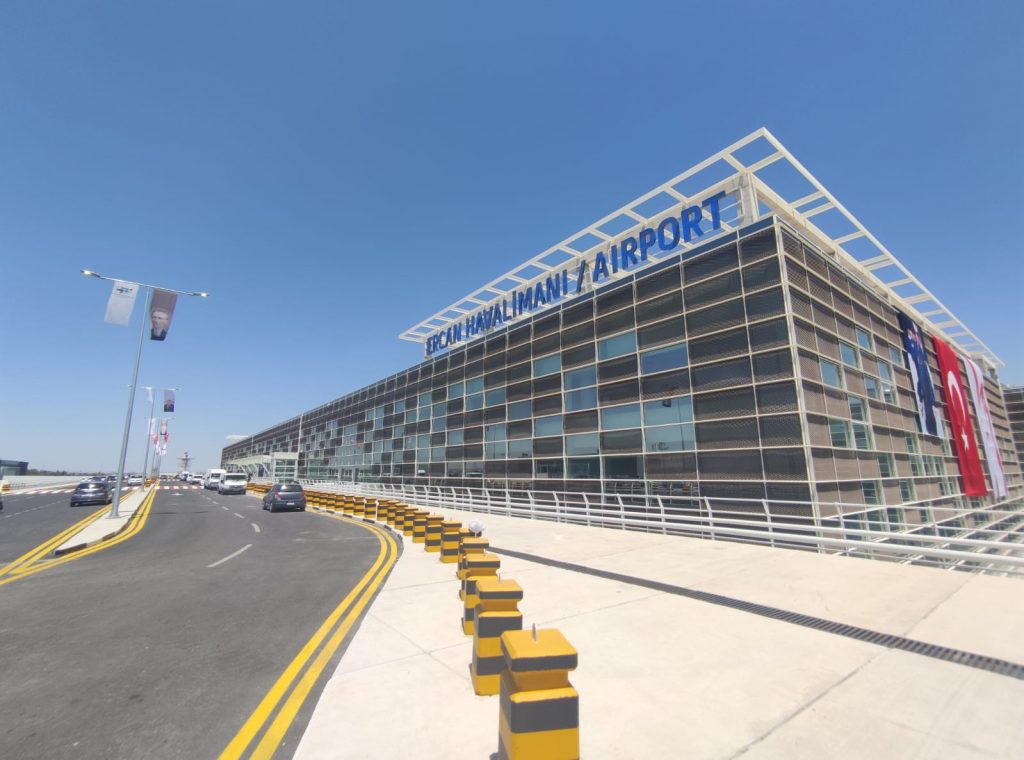The magnificent new Ercan Airport is but the latest reflection of the major development underway in the TRNC, reinforcing the Turkish Cypriot state’s existence to the rest of the world and its ability to offer facilities on a par with any of the recognised states in its region.
Eight years in the making and costing some €450 million to construct, the new Ercan International Airport finally opened last week to great fanfare.
The President of Turkiye Recep Tayyip Erdoğan made the first official flight to Ercan, flying direct to the Turkish Republic of North Cyprus from the United Arab Emirates to mark the opening of the new airport on Thursday, 20 July.
The Turkish president was filmed in the cockpit of his plane getting an aerial view of this vital transportation infrastructure, along with expert commentary from his pilot about Ercan’s key features.
On arrival, President Erdoğan was met by his Turkish Cypriot counterpart, President Ersin Tatar, and dozens of dignitaries from Turkiye and the TRNC to celebrate the occasion. Despite being four years later than planned, Turkish Cypriots finally had a modern new airport they could be proud of.
The final departure from the old Ercan, Turkish Airlines flight 967, travelling from Lefkoşa to Istanbul, left Ercan at 18.45, bringing to a close 48 years of civil aviation activity at the site.
Less than 12 hours later, passengers were arriving at the new Ercan eager to experience all the new airport had to offer. However, as first impressions go, Friday’s performance was poor, with staff and passengers having to navigate major glitches after the airport’s electricity and internet systems went down, grounding aircraft, derailing the baggage handling system, and leaving thousands of frustrated passengers sweltering from the summer heat as the air conditioning also failed in the new terminal building.
The pictures of passengers picking out their luggage by planes, which went viral, was reminiscent of a bygone era. The detractors were out in full force stating the new airport had opened too early and was not yet fit for purpose. Staff behind the scenes worked hard to prove them wrong.
Thankfully, most of these early teething problems appear to have been overcome and passengers have since reported much smoother journeys, with many marvelling at the facilities, size and design of the new airport.
The first commercial flight from the new Ercan International Airport was a Pegasus Airlines flight bound for Adana, which took off at 8.30am on Friday morning, 21 July.
With a longer runway and greater passenger capacity than its main South Cyprus rival Larnaca Airport, the TRNC Transport Minister Erhan Arıklı has declared the new Ercan as “Cyprus’ largest airport”.
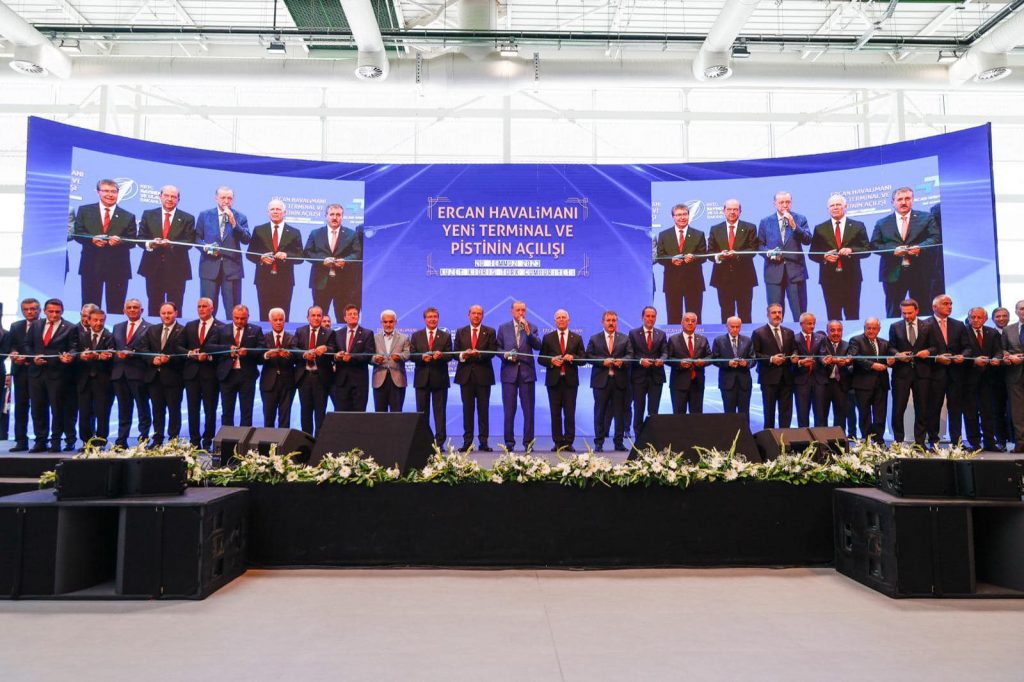
Speaking to media ahead of the official opening on TRNC Peace and Freedom Day, Minister Arıklı said: “The new Ercan Airport will be the largest airport on the island, including South Cyprus, and will hold this feature for many years to come. South Cyprus will not have the opportunity and means to have such an airport for a long time.
“[When Ercan opens] this will be an airport with a capacity of 10 million passengers, but with technical work, it can increase to 15 million. Huge aircraft, including the A-380, will also be able to land at the new airport. We anticipate that ticket prices will drop a little lower when the planes carrying more passengers land.”
The new Ercan International Airport is run by a private company, T&T Ercan Havalimanı İşletmesi (T&T Airport for short), which won a tender from the TRNC government nearly ten years ago to build and operate the airport using a profit-share model. T&T Airport will hand back full control of the airport to the Turkish Cypriot authorities in 2040.
T-VINE explores how this major new facility came about, what it has to offer passengers, how it will benefit the TRNC economy and whether direct flights could become a reality.
What’s new at Ercan International Airport
Ercan International Airport is North Cyprus’ sole civilian airport. It is located in Lefkoşa District, about 8 miles from the capital Lefkoşa / North Nicosia and is a similar distance to the nearest point on the Green Line that separates North and South Cyprus.
By road, the new Ercan is about 3.4 miles (5.5 km) away from the old airport and terminal building. The new Ercan is six times bigger than its predecessor.
The site measures 7.8 million sq m, enabling it to handle up to 10 million passengers per year. This, coupled with Ercan’s longer length piste, measuring 3,200m, makes the Turkish Cypriot airport the biggest on the island of Cyprus, exceeding Larnaca Airport in the South, which has a capacity of 7.5 million passengers and whose 3,000m runway is 200m shorter than Ercan’s.
Ercan’s €450 million tag also makes it the single largest investment and also the largest infrastructure project ever undertaken in the TRNC. By way of comparison, Ercan cost double to build than the previous largest TRNC transportation hub, Karpaz Gate Marina, which opened in 2011 and serves super yachts and yachts in the Eastern Mediterranean.
The project has involved dozens of suppliers and designers, including Hamiltons Architects in London, all of whom have been tasked with creating a great customer experience for all travellers passing through Ercan.
The new North Cyprus airport boasts state-of-the art facilities that are on a par with other modern airports from around the world. Its features include:
- New longer runway measuring 3,200m, allowing larger aircraft to not only land, but to also take off (the old Ercan airport’s piste was 445m shorter, making it unsuitable for large aircraft to take off)
- An apron big enough for 30 aircraft to park, with 9 jetway passenger boarding bridges (the apron at the old Ercan could take just 7 aircraft and had no jetways)
- Large new terminal building measuring 20,000 sq m with 60 check-in desks and 44 passport control points, and room for more, enabling it to handle some 10 million passengers a year
- Improved security with 26 modern X-ray devices
- Baggage screening for 5,000 pieces of luggage per hour
- Sustainable features including solar power, allowing the airport to generate its own electricity
- Bigger departures area housing even more duty free shops and retail outlets with leading drinks and cosmetics brands, and a great range of food outlets
- Parking for 1,500 vehicles
About the name Ercan Airport
The new airport has kept its Ercan name. For those unaware, the Turkish Cypriot authorities decided to call their airport Ercan back in 1975 in honour Squadron Leader Fehim Ercan, a senior Turkish pilot who had died in action in Cyprus on 20 July 1974 – the first day of Turkiye’s military intervention – trying to save Turkish Cypriots.
The old Ercan site was an airport before the Turkish Cypriots had used it. It was constructed by the British during World War II and used as a military airport, but abandoned after the island gained its independence from Britain in 1960.
The nearest village to the airport is Kırklar, or Tymbou in Greek, which is where the airport – RAF Tymbou – got its original name from.
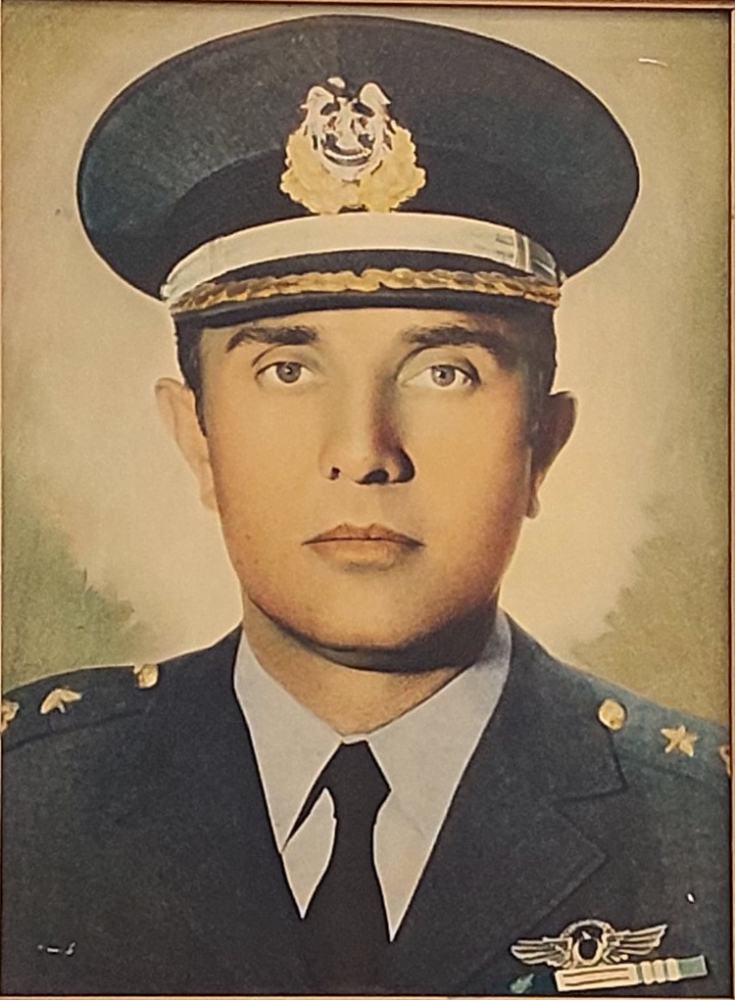
Following the 1974 War, Tymbou / Kırklar, and other nearby villages were abandoned by their Greek Cypriot inhabitants. Turkish Cypriots took over these and also the derelict airport, which they decided to renovate and re-open for civilian use.
The first plane to use Ercan was an F28 type 65-seat jet passenger plane, which landed on the old runway on 3 February 1975. The following year, the original runway left by the British was expanded, allowing bigger aircraft to land.
For decades, Ercan Airport has served as the bridge between the Turkish Cypriot homeland and the rest of the world. Today, Ercan is internationally known and has its own three-letter International Air Transport Association airport code, ECN.
During the five decades it has been in use, the old Ercan airport has undergone a raft of improvements and expansions, yet passenger numbers and the demands for a more modern facility have continued to grow.
Outgrowing the old Ercan
The TRNC Ministry of Transport’s official figures for Ercan for the whole of 2018 showed it had handled some 4 million passengers for that year.
The figures, a year after the UK introduced its disembarkation policy, meant Ercan did not register any drop in passenger numbers, with more travellers from Turkiye compensating for the loss of passengers from Britain.
With 4 million people annually passing through Ercan, the pressure for a new terminal building with better facilities was never greater.
Another major cause of concern was the poor security infrastructure at the old Ercan, which was cited by the British authorities in their communications to airlines flying into the UK from North Cyprus in 2016 and 2017.
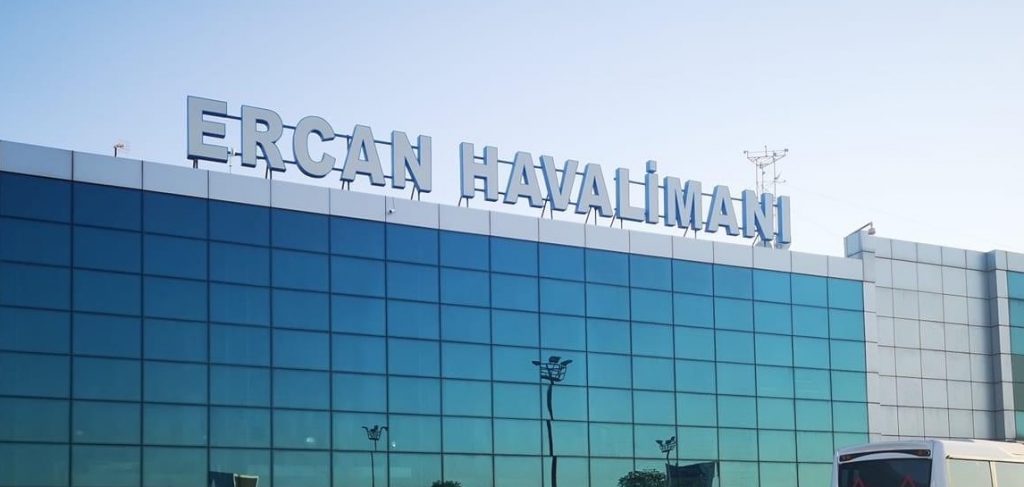
In June 2017 the UK introduced a disembarkation policy, which forces all London-bound passengers from Ercan to get off the plane in Turkiye and go through a fresh security check before reboarding.
This policy – which many view as politically-motivated – has added significantly more time, cost, discomfort and stress for passengers travelling from the TRNC. Not surprisingly, many heading to the UK have switched to flying from South Cyprus airports. The situation underlined the urgency of moving to the new Ercan where security facilities would be on a par with international standards.
TRNC Government gave green light for a new Ercan in 2012
The plans for a brand new airport for North Cyprus, and not merely another Ercan expansion, had started back in 2012. At the time the TRNC, led by Prime Minister İrsen Küçük and his conservative National Unity Party (UBP), took the decision to allow a private contractor to operate the existing Ercan Airport and to build a new airport on a nearby site using the Build-Operate-Transfer (BOT) model.
The BOT model was a popular means for governments around the world to deliver major public infrastructure projects without being burdened with the responsibility of finding the large levels of finance needed or the task of building them. Such an approach appealed to the Turkish Cypriot government, which had neither the money nor the expertise to undertake such a major venture. Through BOT, the new Ercan would not cost the TRNC taxpayer a single lira.
The Ercan Airport tender process opened in May 2012 and ended on 27 August of the same year. The TRNC Government announced in October 2012 that a Turkish firm, Taşyapı, headed by Turkish businessman Emrullah Turanlı, and its partners Terminal Yapı and Turkish Cypriot firm Kanerler had won the tender. They were awarded a 25-year licence with the new Ercan expected to be built and ready for use at the end of 2018 or early 2019.
The partners formed T&T Ercan Havalimanı İşletmesi (T&T Airport for short), and the TRNC Government formally transferred the running of the existing Ercan Airport to T&T Airpot on 1 January 2013.
As part of the long-term agreement with the private contractors, some of the land around the airport that was being used by the TRNC and Turkish military was returned to civilian use. It was then handed over to T&T Airport, giving them the space to build the new Ercan Airport.
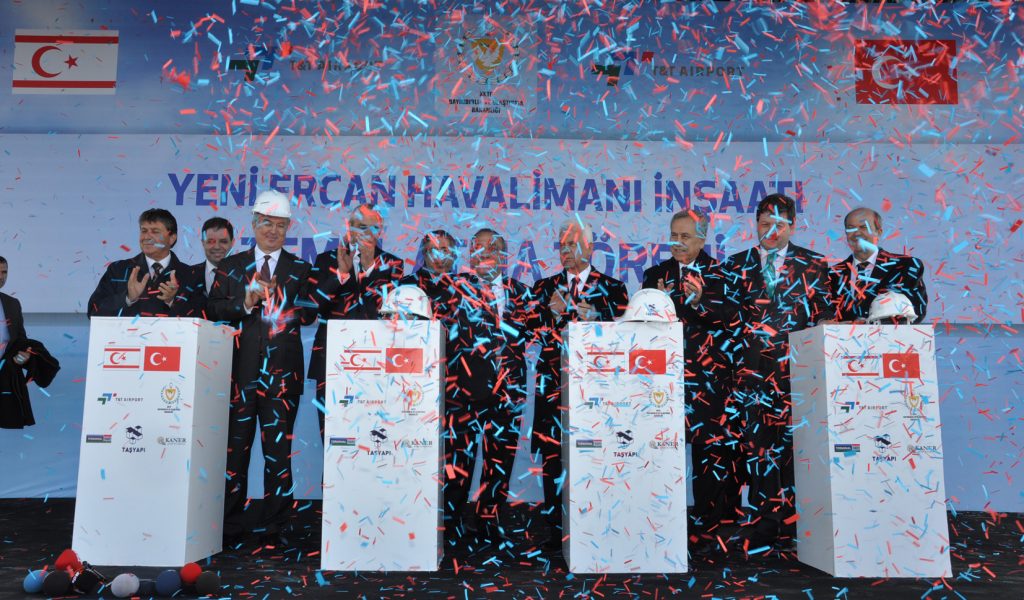
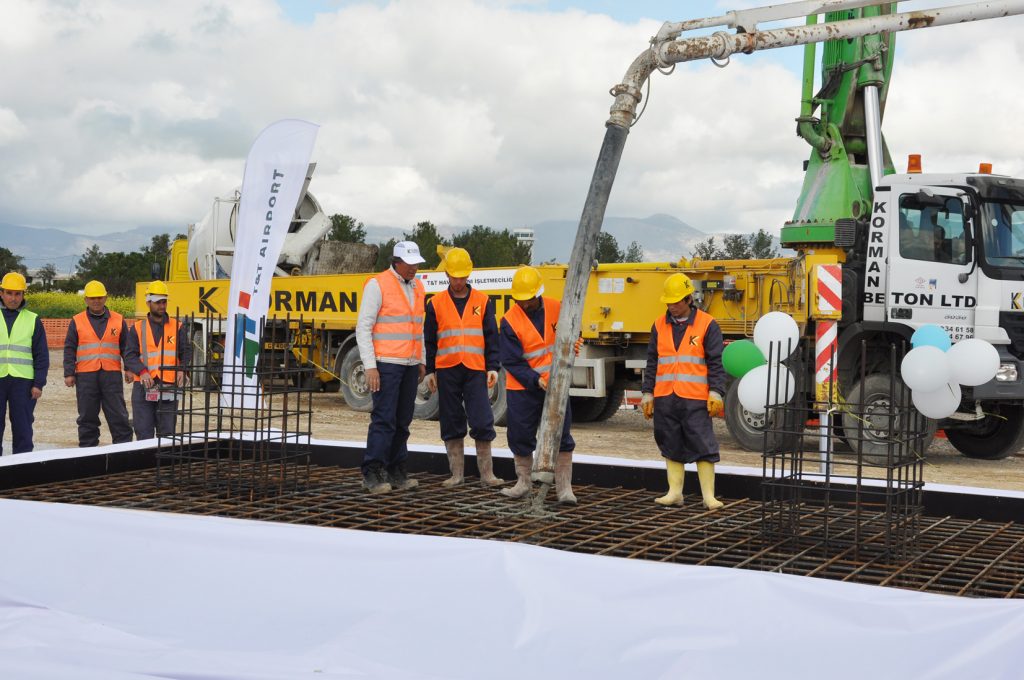
On 12 February 2015, TRNC President Derviş Eroğlu and Türkiye’s Deputy Prime Minister Bülent Arınç were among those present for the foundations ceremony, marking the start of the construction of the new Ercan.
Behind the scenes, Taşyapı, which owned 70% of the project, and Terminal Yapı (20% project owners) were having a major fallout. Terminal directors accused T&T’s biggest shareholder of deliberately excluding them from T&T Airport affairs and failing to give Terminal their share of the investment raised (at that time some €300 million). Taşyapı responded by stating it was acting fully in line with their partnership agreements. The matter ended up in court in 2015.
The Terminal Yapı spat formed one of two legal challenges Taşyapı faced. The other was brought by the TRNC’s Constructors’ Union, which accused the Turkish firm of failing to adequately use local TRNC firms for the airport’s construction, as required by T&T’s licence. The court case ran for seven years, with the Constructors’ Union finally victorious in March of this year.
The court’s verdict resulted in Taşyapı’s Ercan construction licence being temporarily revoked, bringing to a halt all works at the airport, which was already four years behind schedule due to financial difficulties and the coronavirus pandemic. The issue was only resolved through the intervention of the TRNC and Turkish authorities, allowing work to resume.
Benefits to the TRNC economy
Taşyapı, which was formed in 1985, has extensive construction experience with its resume boasting landmark properties and infrastructure projects not only in Turkiye, but also across Central Asia, the Middle East and the Balkans. They had been successful in raising the finance to build the new Ercan Airport and any further delays was not in their, the investors’, or the TRNC government’s interests.
Under the 25-year agreement with Taşyapı and its partners, the TRNC Government receives just under half of all profits, 47.8%, that T&T Airport generates from Ercan International Airport. Turkish Cypriot ministers have estimated that annually, this profit-share arrangement will see €30 million go into state coffers.
There will undoubtedly be many more positives to the North Cyprus economy, including more tourists, new employment opportunities, and ongoing work for local businesses serving the airport and tourism sector. However, details such as how many people are employed at the new Ercan Airport and the other anticipated benefits have yet to be published.
What about direct flights to Ercan?
By overcoming security concerns and practical needs for larger aircraft, the new airport has also raised the prospect of direct flights to North Cyprus.
Ercan currently receives daily scheduled and chartered flights from four airlines, all registered in Turkiye: Turkish Airlines, Pegasus Airlines, Anadolu Jet and Fly Kıbrıs Airlines.
In comparison, the largest airport in South Cyprus, Larnaca, serves over 50 airlines whose origins include Europe, the Middle East and beyond.
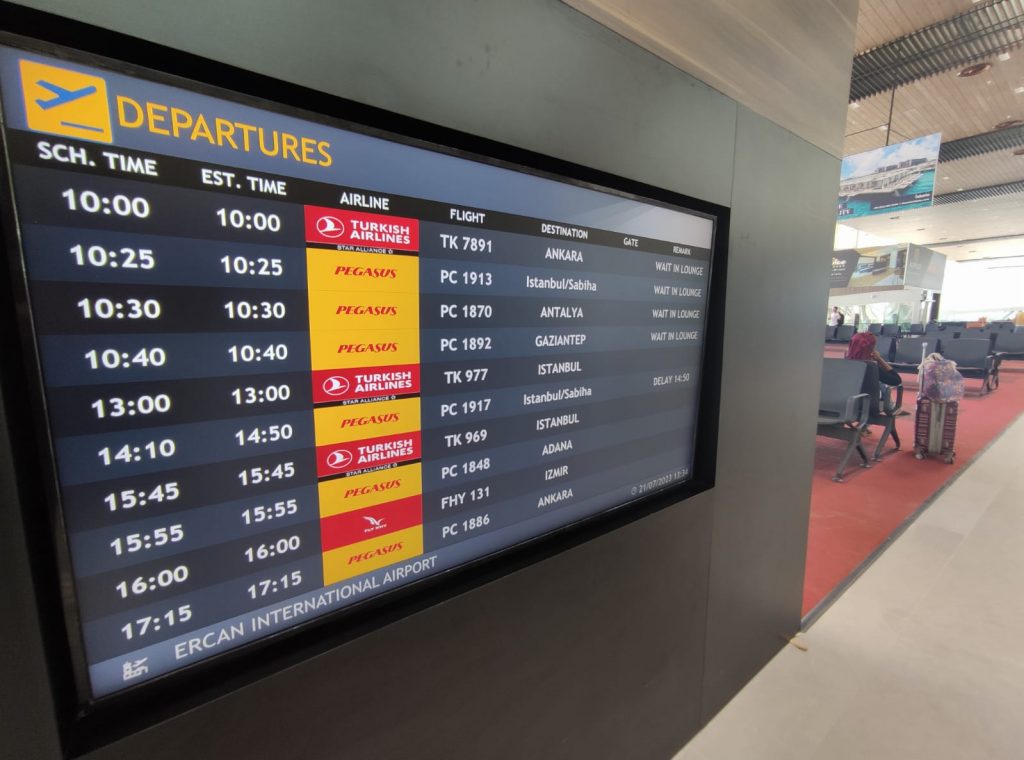
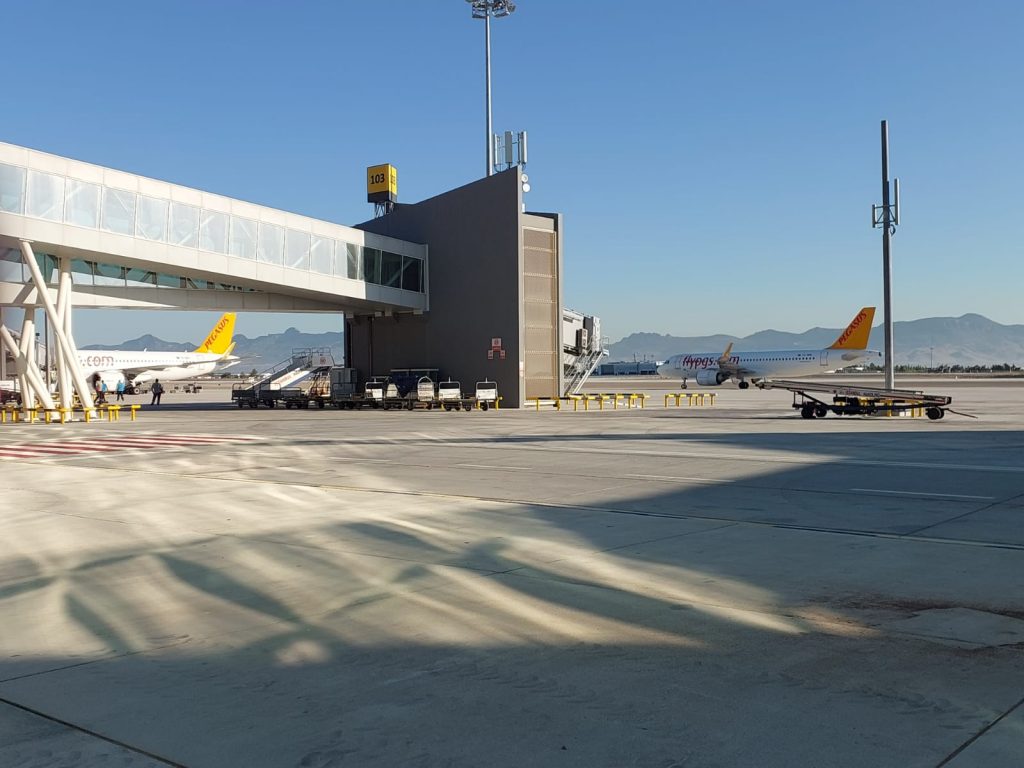
While airlines can fly direct to the two airports in South Cyprus, Larnaca and Paphos — both of which are built on Turkish land — the Greek Cypriot authorities object to airlines flying direct to Ercan, insisting they touchdown in Turkiye first – an issue rooted in the long-running Cyprus Conflict.
Although there are two states in Cyprus, politically, most of the world only recognises a country called the Republic of Cyprus, which came into existence as a power-sharing state between Greek and Turkish Cypriots in August 1960. However, following a bloody coup in December 1963, the state was seized by Greek Cypriots and despite considerable effort by the international community to unify the island, they have refused to share power with their former partners ever since.
Since 1964, the Greek Cypriot side has behaved as if it is the sole representative of the Republic of Cyprus and, by misusing the Doctrine of Necessity, they wrongly claim they can unilaterally determine which of the island’s ports can be used and which cannot. This includes those ports in North Cyprus, despite Greek Cypriots not exercising any control over this territory since August 1974.
Successive South Cyprus governments have insisted that the International Civil Aviation Authority and its members do not recognise or permit flights to Ercan Airport in the north. Yet airlines from Turkiye have been disregarding this directive since 1975, as have the owners of private jets and chartered aircraft, without any problems.
In 2005, Imair, a commercial airline from Azerbaijan, set out to be the first airline outside of Turkiye to fly direct to the TRNC. Over 90 passengers made the historic trip on an Imair flight from Heydar Aliyev International Airport in the capital Baku to Ercan Airport on 27 July 2005.
As a European Union member state, the South Cyprus government complained to European Commission officials about the Imair flight and the airline was threatened with losing its EU license, forcing it to cancel all future direct flights to Ercan. Similar threats have put off other airlines from trying the same.
UK rejects direct flights from Ercan
The following year, the Turkish Cypriot national carrier Kıbrıs Türk Hava Yolları (KTHY) and its UK subsidiary Cyprus Turkish Airlines (CTA) applied to the British authorities for a variation of its operating permit, to allow it to carry passengers, baggage and cargo on scheduled services between the United Kingdom and North Cyprus.
A second application, submitted on the same day, 23 November 2006, was made “on behalf of KTHY and CTA for an operating permit under Article 138 of the 2005 Order to allow them to operate specified charter flights between the United Kingdom and Ercan airport in northern Cyprus,” according to court papers filed at the High Court.
When the British Secretary of State refused both applications, KTHY and CTA challenged the decision via a judicial review. The Greek Cypriot-administered Republic of Cyprus was allowed to join the case as an “interested party” and the Turkish Cypriot side subsequently lost the judicial review. They decided to appeal the decision and the case proceeded to the Court of Appeal.
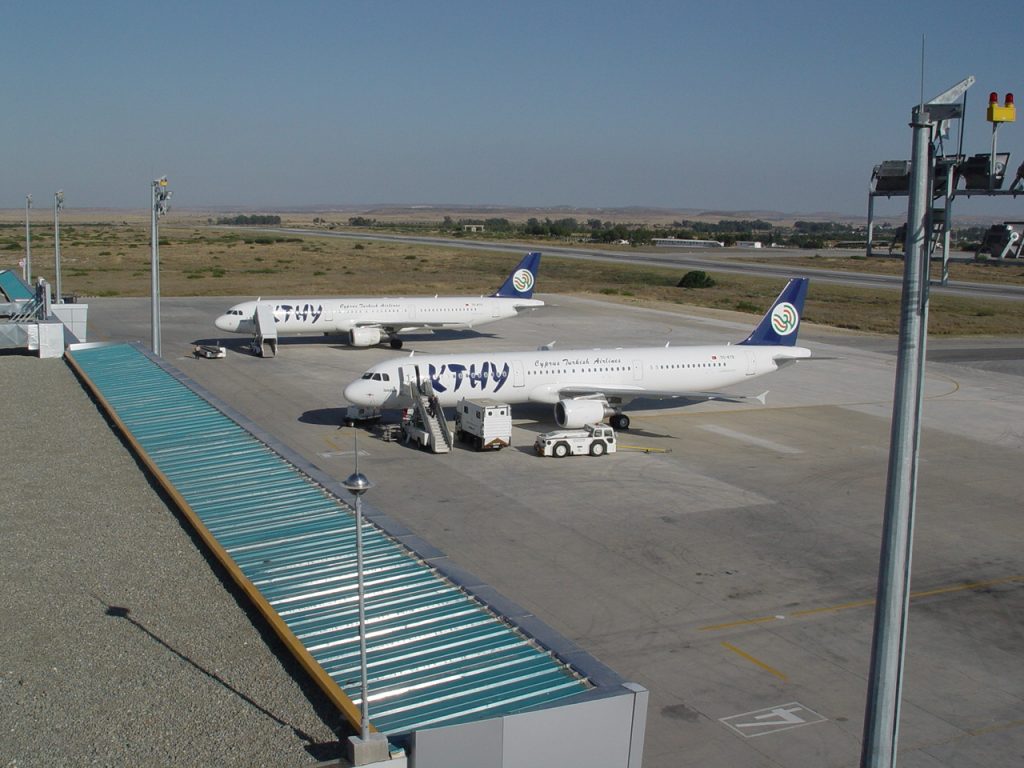
In 2010, the three judges that heard the case at the Court of Appeal upheld the earlier High Court decision. Their judgement acknowledged the practical difficulties for those travelling to and from North Cyprus via Ercan because of the enforced touchdown in Turkiye, but they believed the circumstances were not exceptional enough to override the Chicago Convention of 1944, especially as British citizens had the option of crossing over the Green Line and using the two airports in the South, where direct flights were possible.
The decision shocked Turkish Cypriots, not least because the United Kingdom is a Guarantor Power of Cyprus that is obliged to treat both the Greek and Turkish Cypriot sides equally. Many political observers believe that the UK was obliged to deny Turkish Cypriots their application in order to protect their two military bases, Akrotiri and Dhekelia, which although are primarily built on Turkish-owned land, are located in southern Cyprus making them vulnerable to Greek Cypriot pressure. The 2017 disembarkation policy of the UK is seen as a continuation of this approach to pacify Greek Cypriots.
Under these circumstances it is difficult to see how an airline regularly flying to a British or EU destination will risk their EU or British operating licences by flying direct to Ercan. However, a positive precedent could come from those airlines which do not fly to European destinations, such as the newly formed Fly Kıbrıs, or one of the Russian airlines which have been barred from European and British airspace.
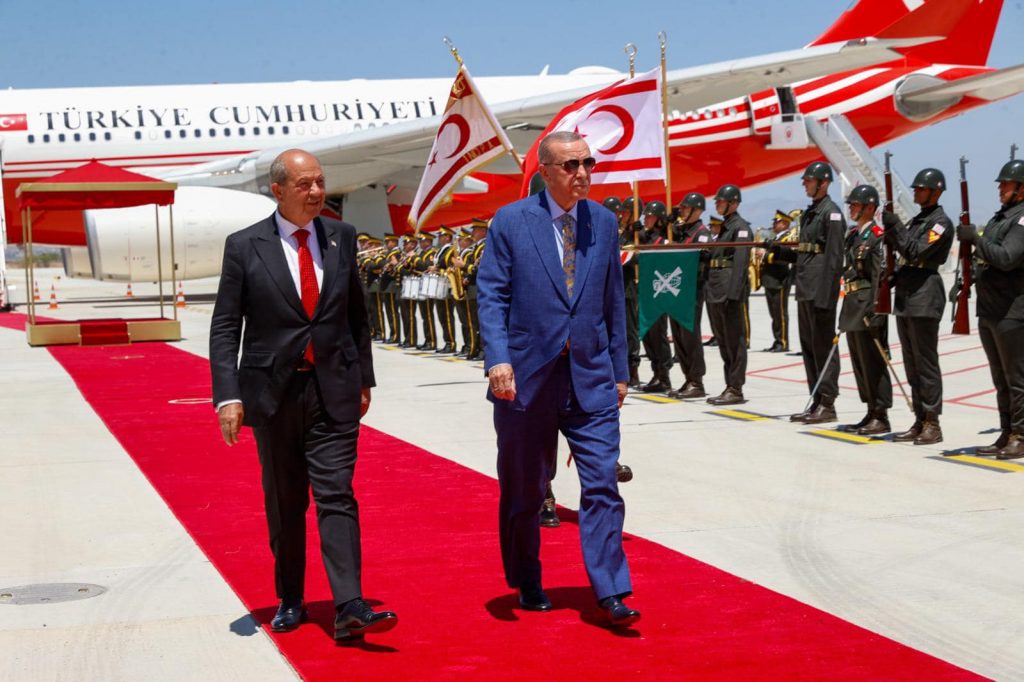
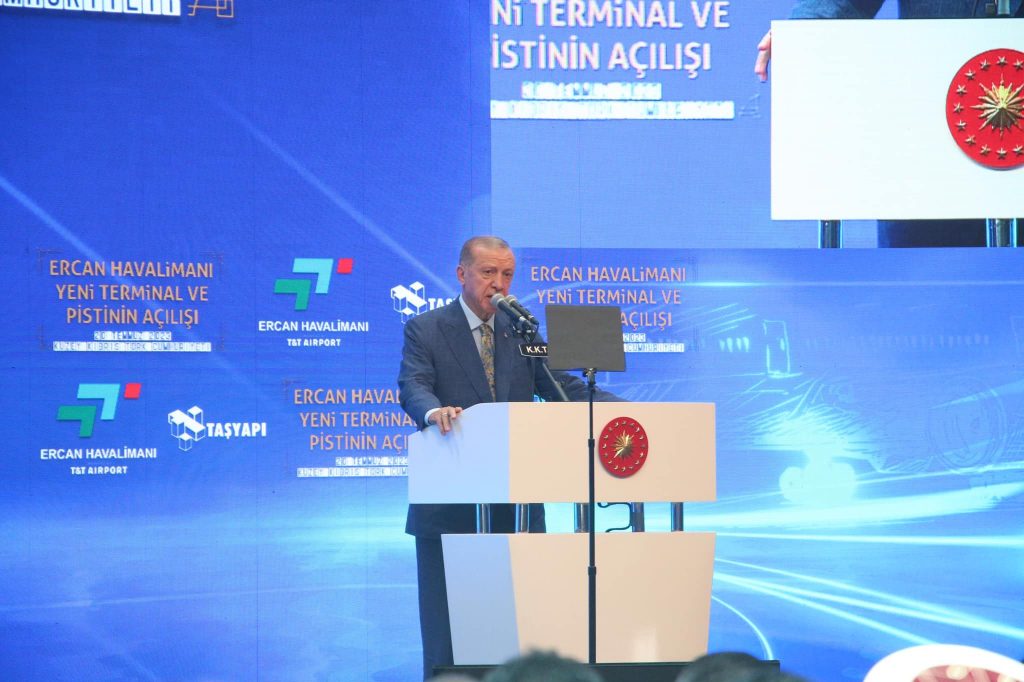
The fact that the Turkish President has made two very public direct flights to Ercan in as many months has encouraged some excitement among the pro-TRNC camp. The first flight was after President Erdoğan’s May re-election victory, when he travelled non-stop to Baku from the TRNC, which he had visited on 12 June. On 20 July, the Turkish leader flew directly to Ercan International Airport from Abu Dhabi in the United Arab Emirates.
As President Erdoğan stated in his speech at the opening of the new North Cyprus airport, there is no “legal basis” for barring international flights to Ercan and called on the international community to end their travel embargo:
“On this occasion [of the opening of the new Ercan Airport on 20 July 2023], I invite the international community to heed the call of then-Secretary-General Kofi Annan, who admitted that there is no United Nations Security Council resolution that will excuse or justify the isolation of our Turkish Cypriot brothers, and to remove these totally politically motivated restrictions, devoid of any legal basis. I reiterate my call to support the ideal of two equal states living side by side, not domination, tension and conflict culture on the island of Cyprus.”
It remains to be seen who will heed President Erdoğan’s call and, separately, what steps the Turkish and Turkish Cypriot authorities will take to drive the end of the unjust embargoes on North Cyprus.
One thing is for sure, the magnificent new Ercan Airport is but the latest reflection of the major development underway in the TRNC, reinforcing the Turkish Cypriot state’s existence to the rest of the world and its ability to offer facilities on a par with any of the recognised states in its region.

